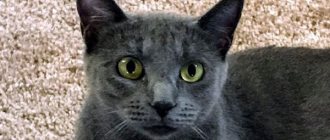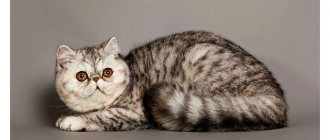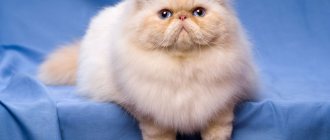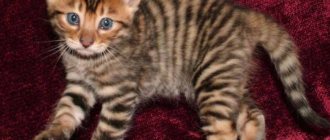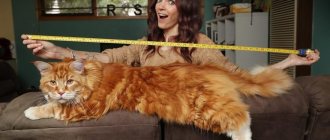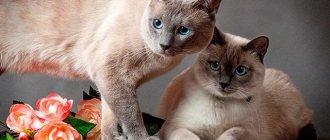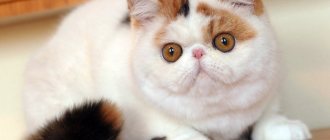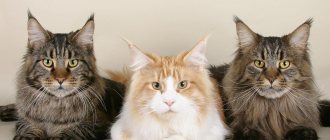Why do cats have blue eyes?
Eye color in almost all cases directly depends on genetics, but there are exceptions, for example, when eye color changes as the cat grows up or this is explained by a lack of melanin. It is these pigments that are responsible not only for the color of the iris, but also for the color of the skin and coat color.
In addition to blue shades, others may be present; heterochromia is also common among such cats. This is one of the pathologies of the color of the iris, when the shade is uneven or the eyes are completely different colors.
There are a lot of cat breeds with blue eyes in the world and here are the most popular ones.
Features of the blue eye color gene
At birth, all kittens are born blue-eyed, which can be explained by a lack of melanin, the substance responsible for color pigment. As growth and development progress, the iris acquires the shade the baby inherited from the parents, usually taking from 4 to 12 weeks. But sometimes a kitten retains blue eyes for the rest of its life for several reasons:
- presence of a dominant white gene. White cats most often have blue eyes. The white gene, designated by the letter W, can cause deafness in a cat, as it negatively affects the formation of cells that are responsible for hearing acuity. But this may not happen to every white-haired pet;
- albinism. Blue-eyed albino cats are a fairly rare but existing phenomenon. Siamese cats also have the albinism gene, which is why their fur is partly bleached and their eyes are blue. Lightening occurs due to the thermal sensitivity of the wool in some places. Due to temperature changes, the fur changes color and acquires a Siamese color;
- spotting. The tortoiseshell color often has white in its color scheme. If the white spot is near the eyes, then they will also acquire the W gene and become blue;
- involvement in blue-eyed cat breeds. For example, the Ojos Azules breed has this name due to the presence of the blue color of the iris, and the cat itself can have fur of various shades. Ojos Azules do not have visual or hearing impairments.
Blue eyes in cats can occur for many reasons.
Albino cats differ from cats with a snow-white coat by the absence of the color gene and are very rare: one albino in ten thousand animals.
The layer of the eyeball called the tapetum, which reflects light at dusk, appears yellow or green in photographs in normal cats, and red in photographs of albino cats.
There are very few breeds of blue-eyed cats, and those that exist are rated very highly by cat lovers around the world.
Javanese
The longhaired breed is one of the varieties of domestic cats. By their nature, they are also mischievous, so they should not be left without toys and unattended. They themselves are friendly and affectionate, but despite this they are very stubborn, get used to their owners and have a hard time with separation.
Their health is not the best, they need to be protected and given a lot of attention to care. An interesting feature is the unique structure of the wool, to which people are not allergic. One can note very beautiful eyes, but despite this, strabismus is common among this breed.
Javanese
Balinese cat
This is also a long-haired domestic breed. They become very attached to their owner, they are loyal, devoted and constantly require attention, but even with such affection they will feel fine alone. Cheerful, active, friendly, easy to get along with children and pets in the house. They need a lot of space to use their energy to the fullest. The physique of such cats is slender and muscular, which can explain their energy. Unfortunately, this breed cannot boast of good health, so they need careful care.
Balinese cat
Himalayan cats
This is a breed of long-haired cats with a fairly thick coat. They are sociable, friendly and inquisitive, they get very used to people, they also love attention to their person, but at the same time they are comfortable being alone. By nature, they are not the most active, preferring peace and quiet, so they are great for people with a similar lifestyle, but for active people this is not the best option. The body of representatives of this breed is round in shape, the paws are not long. Unlike the previous ones, these cats have excellent health and rarely get sick.
Himalayan cat
Cat breeds with blue eyes
Among the breeds of blue-eyed cats, there are the most famous ones, which are popular with both professional breeders and lovers of furry friends.
Siamese cat
The Siamese cat is one of the oldest and most famous representatives of the cat family. It originated from Thailand and quickly gained popularity around the world. Externally, Siamese are very similar to Thai and Oriental cats, but one of the most striking distinguishing features is their bright blue eyes. Siamese also have a long and slender body with pronounced muscles, large triangular ears and a flexible, thin tail. The breed has dark spots on its limbs and face, and its coat color ranges from cream to chocolate.
The Siamese cat is an animal whose appearance creates a general impression of slenderness, lightness and swiftness.
Siamese are proud and self-confident cats that demand attention. They have a fickle and explosive nature and can be either capricious and nervous or loyal and friendly. Despite the fact that Siamese cats become attached to their owners, they have no authority, and therefore their trust is very easy to lose. The Siamese does not like affection, but will happily share active games and walks in the fresh air. There will never be a dull moment with a Siamese cat.
Sacred Burma
The state of Myanmar (formerly Burma) is the birthplace of the Burmese cat. In ancient times, the breed was considered sacred and lived in temples. At the beginning of the 20th century, a millionaire from America imported the Burmese cat to Europe, after which it became widespread. Getting to know Burma is not difficult. This is a semi-longhaired color-point cat with white “gloves” on her paws. The Burmese has a medium-sized body with short legs and a bushy tail, round cheeks, and bright blue eyes.
Where Burmese cats walk, there is no place for negative emotions - only goodness and positivity
Burmese cats have wonderful personalities. They are affectionate, inquisitive and loyal. The breed is very attached to its owner and gets along well not only with all family members, but also with other pets in the house. Burma loves to be the center of attention and share a wide variety of activities. Calmness and balance do not allow her to cause damage to her home environment or enter into conflicts with other animals. Burmese cats gladly accept affection and are always warm and friendly towards new faces.
Khao-mani
Since the times of ancient Siam, kao-mani was considered an indicator of the wealth of the family in which it lived. And now this snow-white beauty is highly appreciated by both ordinary cat lovers and professional breeders. The Kao Mani is an example of a breed that can have both blue and multi-colored eyes. The latter phenomenon is called heterochromia, it appears when the eyes are located on areas of the coat that differ in color. In addition to beautiful eye color, Kao Mani has short snow-white fur, a wide forehead, large ears and a strong tail.
The grey-blue shiny eyes of these cats fascinate with their beauty; it is not for nothing that the name of the breed is translated as “diamond eye”
People believe that kao mani with different colored eyes can bring good luck.
The Kao Mani is an easy-going and friendly breed that requires a lot of attention. She quickly gets used to her owner and cannot stand being alone. Kao-mani is very vulnerable and can be offended for a long time, and therefore you should not have such a pet at home if you do not have the opportunity to pay attention to it every day. A cat of this breed easily gets along with people and other pets in the house. Very playful and intelligent, amenable to training with simple commands and has a developed hunting instinct. Possessing this quality, the kao-mani will immediately rush to the defense of its owner and once again prove its loyalty to him.
Ojos Azules
Ojos Azules is a unique cat breed with blue almond-shaped eyes and a wide variety of coat colors. The differences in the exterior of this breed from others are not very pronounced, and therefore there are many variations in the appearance of the Ojos Azules. Nevertheless, there are general standards: an elegant and strong body, giving the appearance flexibility and fit, high ears, a tail proportional to the body.
The main advantage of Ojus Azules is its bright blue almond-shaped eyes.
Ochus Azlues is suitable for people who prefer to spend their free time in a quiet home environment, because this breed is extremely peaceful and calm. Despite the attachment to the owner, the pet will not depend on his attention and will calmly endure some time of loneliness. Ojus azules feels comfortable in silence, away from large companies. So don’t be surprised if your cat goes missing if noisy guests come to your house. Despite the love of calm, a representative of this breed will happily share active games and outdoor activities. Ochus azules easily finds a common language with other pets and lives under the same roof for many years without any conflicts.
Important! Under no circumstances should representatives of this breed be crossed with each other, since the altered blue eye color gene affects the health and vitality of the kittens.
Himalayan cat
The Himalayan cat is the result of crossing the Siamese and Persian cats. From the Siamese she inherited blue eyes and an unusual color with dark spots on her face, paws and tail, and from her Persian ancestors she got a fluffy and soft fur coat. The Himalayan cat gives the impression of a strong and strong animal due to its powerful body, muscular legs and pronounced chin contour. The luxurious coat of this breed requires constant care and careful daily brushing.
The Himalayan cat has the fur of a Persian cat, the flexible body of a Siamese, blue eyes and an independent disposition.
This breed is very affectionate and playful. She loves the attention of her owner, happily settles on his lap and loves when her soft fur is combed and stroked. Despite its attachment to its family, the Himalayan cat can easily endure loneliness when they are not at home. Representatives of the breed skillfully maintain a balance between love for humans and their independence. They are unobtrusive and never achieve anything with persistent meowing. Sometimes cats have short bursts of energy, during which they actively participate in games and ventures, but mostly they prefer to spend time in lazy contemplation of their surroundings. The Himalayan cat gets along well with all family members and other pets in the house. This breed makes an excellent companion for older adults.
Oriental cat
The white oriental cat is related to the Siamese, but unlike them, it has a solid white coat, which can be either long-haired or short-haired. The graceful Oriental is both graceful and muscular, her long body with an elongated neck is crowned by a triangular head with large ears. Almond-shaped eyes can both be blue or multi-colored. The white oriental cat is one of the most popular breeds that fascinates cat lovers with its aristocratic appearance.
A long graceful body, a wedge-shaped head, large ears - a white oriental cat can be seen from afar
This graceful beauty considers herself the center of the universe and loves attention to herself, and therefore begins to suffer and be offended if she does not receive it for a long time or is alone. She is very talkative: she will definitely express her dissatisfaction or joy by meowing. The breed loves to communicate with people and other pets, play and share various activities, and is always ready to stand up for itself and fight back against the offender. The white oriental cat is very energetic and active, she loves to explore all the secret corners of the house and climb even to heights that seemed unattainable. Therefore, if you want to have a representative of this breed at home, it is better to take care of indoor plants, which will definitely be disturbed by the new inhabitant at a convenient moment.
Turkish Angora
The Turkish Angora is one of the oldest cat breeds. It appeared in Turkey and in ancient times was a very expensive and valuable gift, and therefore its owners were monarchs, sultans and other high-ranking officials. And now the Turkish Angora delights with its beautiful snow-white coat and pleases with its pleasant disposition. Representatives of this breed have a muscular body, a bushy tail and high-set, tufted ears. Almond-shaped eyes can be multi-colored.
Outwardly, this breed of cat looks stern and unapproachable, but in fact the Turkish Angora is very affectionate and friendly.
This breed is very brave, determined and persistent. She always achieves her goals, be it a toy put away on the top shelf of a closet, or a tasty treat. He loves to play and generally does not sit still, sometimes even forcing him to chase after himself. The Turkish Angora is friendly, it gets along well with pets and households, it becomes very attached to its owner, most often singling out one of the large family. This cat is soft, affectionate and friendly. She does not like loneliness and always needs company and active pastime. Despite its cheerful and gentle disposition, the Turkish Angora can stand up for itself and will never allow itself to be offended.
Blue British cat
The British cat is one of the most popular breeds not only in the UK, but throughout the world. It is characterized by a strong body with strong limbs, a round muzzle and a short tail. The British cat's coat is short, shiny and thick. Among lovers of the breed, special attention is paid to the blue coat color, which even received its own name - British Blue. But these cats can have fur of a wide variety of shades, of which there are currently more than a dozen. There are also several variations in eye color: from bright orange to blue, depending on the color.
Color-point cats have blue eyes, and rare chinchilla cats have lavender, blue or emerald green eyes
This breed has a sense of self-esteem, it is calm, intelligent, intelligent and restrained in emotions. Very clean and does not require complex care. British cats are very affectionate, they quickly become attached to their owners, without singling out one person, as other breeds often do. Thanks to his independence, the British spend time quietly alone, but always look forward to the return of his family to chat or just sit next to him. This trait allows busy and hard-working people to own a representative of this breed. But despite the ability to easily tolerate loneliness, the pet needs affection and care, and therefore it is important to pay enough attention to your pet in his free time.
Scottish fold cat
The appearance of this interesting breed is caused by a natural genetic mutation. It all started with an ordinary Scottish cat, Susie, who had slightly curved ears. Her kittens were subsequently crossed with the British Shorthair breed, resulting in these unusual creatures, which are now called Scottish Fold cats. The body of the breed is strong with short but soft limbs, the tail is proportional to the body. The thick, plush coat comes in a variety of colors and can be either long or medium. Eye color ranges from hazel to blue.
The Scottish Fold cat is a sweet creature with a wonderful character, capable of quickly adapting to a new environment and people.
Scottish Fold cats are very loyal, kind and sweet animals that choose one person from all family members and follow on his heels. But despite their devotion, they cannot be called intrusive and demanding: most often it is enough for them to simply be near their owner, and not to take all his attention. Fold-eared Scots treat large and noisy companies calmly and quickly adapt to a new environment. The breed does not suffer from hyperactivity, so there is no need to worry that in your absence at home some valuable object will break or a flower pot will tip over due to the efforts of your furry friend. These cats love to meditate on their backs, stretching out their paws, which once again proves the calmness and tranquility of this breed. You should not leave your Scottish pet alone at home for a long time: he may get bored. For example, another good-natured pet can correct this situation.
Javanese
Another result of the work of breeders is the Javanese, which was obtained by crossing short-haired colored breeds with the Balinese cat. The homeland of this unusual breed is North America. Geneticists wanted to diversify the Balinese breed with other colors. The result is an animal for which several types of colors are allowed: from cream to blue. The Javanese cat has a long body, a fluffy tail that stands out against the background of the fur all over the body, and an elongated muzzle with large ears. Almond-shaped eyes have a rich blue color.
Thanks to the elongated muzzle and large ears, we can confidently say that Orientals are the rightful ancestors of the Javanese
The breed is playful, curious and restless. As they grow older, their activity decreases slightly, but the Javanese still remains a lover of outdoor games and exploring the contents of even the tallest drawers and shelves. This animal needs space for action, and therefore it is not suitable for those people who like to maintain perfect order in the house . Javanese will happily throw objects around, carry things throughout the apartment and bring various trinkets to the owner. Javanese does not like loneliness, he gets very bored in the absence of people, and upon their return he follows on their heels everywhere and does not give way. The Javanese cat shows its lively and strong character in any conflicts or situations where it needs something: it will stand up for itself without delay and will definitely achieve what it wants.
Burmese cat
This is one of the old breeds that appeared back in 1919 in Europe; the cats themselves are small, although they create the illusion of massiveness. They are good-natured, affectionate and get along well with other pets in the house and do not cope well with loneliness. Yes, they are playful, cheerful and curious, but at the same time quite calm. The main feature of this breed is its color, which acquires a different shade with age.
Burmese cat
Genetics of black color
Many Internet pages are full of photographs of black cats. What gives these animals such a beautiful color? The pigment eumelanin, which is responsible for the formation of black color, is responsible for this. This pigment is present in the cat’s hair in the form of granules, and the shade of the cat’s color depends on what shape they are, how much they are contained and where they are located. For example, the rich black color of the coat is given by the B (Black) gene in a dominant state. In this case, the eumelanin granules have a slightly elongated shape at the poles and are placed very tightly. In other, recessive conditions, the gene contributes to the appearance of calmer shades. Thus, species b pulls out pigment granules and separates them over long distances, resulting in a chocolate color. And the bl form further expands and moves the granules away from each other, resulting in a cinnamon color.
In most cases, black cats give birth to black kittens.
Perfect black cats are rare. At least minimally lightened areas are still present on the body, but they are often very well hidden and not noticeable.
Black cats are not a separate class. This color can be found in any breed. But blue eyes among them are a very rare phenomenon. Here are some of the cases where black cats have been observed to have blue eyes:
Bombay
Kittens are usually born with blue eyes, but as they age the color changes to yellow.
Oriental
Black Orientals even have jet black noses and toes.
Canadian Sphynx
Canadian Sphynx cats have unusually short mustaches.
Thai cat
This breed became famous in history; there are many legends and beliefs about them; it was believed that they drove away evil forces. Pets are relatively small, strong and slender. This breed is distinguished by good health and long life. They become strongly attached to their owners and cannot stand loneliness, and can appear stubborn and independent. They themselves are very smart, cheerful, playful, energetic and never sit still, noisy, they find it easy to communicate with other pets, but only in the role of leader.
Thai cat
Other breeds of gray cats
There are also breeds for which gray coat color is one of the acceptable color options. Among them there are spotted and solid, smoky or lilac, dark gray or light, silver cats.
Egyptian Mau
The Egyptian Mau breed is allowed only three colors, two of which are gray. Silver cats have a light gray, steel-colored fur, while smoky cats have silver or gray fur. In both cases, the color is not supposed to be solid; there should be black or dark stripes and spots. The silver coloring is accompanied by black edging around the mouth and eyes.
British
There are about 200 color varieties included in the British breed standard, most of them being variations of the gray color.
The fur of purebred British dogs is uniformly colored. Spots or streaks of any color do not meet the standard.
Scottish
The gray color of Scottish cats is not the only acceptable color for the breed, but it is the most popular. A fat gray cat with a touching face and curled ears appears much more often than other Scots in photographs on the Internet.
The cat's coat should have an even color. In addition to the blue tint, Scots can be silver, marbled, or chinchilla.
Snow-shoe
Can be considered one of the newest shorthaired breeds. This is the result of crossing bicolor American Shorthairs with Siamese cats. The breed has an amiable character and a pleasant voice, and they do not create noise at all. They are affectionate, curious, friendly, absolutely unobtrusive, and in places they can be independent and proud. They hate loneliness; a long stay in this state contributes to very big changes in behavior.
Cats of this breed interact well with all pets and love children. It may seem strange, but these cats are incredibly fond of water and will never miss the opportunity to take a little swim.
Snow-shoe
Ragdoll
These cats are large (the third largest in the world) and have unparalleled thick and long hair. They differ from others in their passivity and relaxed muscle tone. Their character is quite pleasant, they are friendly, good-natured and affectionate, they are also very smart and incredibly loyal. They can also be considered excellent companions for other pets and children, because they completely lack aggression. The ideal living environment for this breed is peace and quiet, they cannot tolerate noise, but under no circumstances should they be left alone. They also differ in their slow development.
Ragdoll
Foreign white
The Shorthair breed is the result of crossing a White British Shorthair and a Siamese cat. Representatives of this breed are distinguished by intelligence and intelligence, thanks to this they can even teach and follow commands. They have a very slender and muscular physique, and at the same time they have an inherent grace. They are kind to their owners and get used to them, they get along well with children, but still such a cat needs to be handled carefully. But as for relationships with pets, here it is simply vital for such a cat to take a leadership position. By their nature, they are quite calm and balanced, they will not get underfoot and impose themselves, but it is still not recommended to leave them alone.
Foreign white
White Persian cats
This is one of the most ancient breeds, it appeared in the 16th century. Cats are not the largest, medium-sized, and have thick, long and fluffy hair. By nature they are affectionate, peaceful and friendly, preferring tranquility and a more passive lifestyle, although they also like to play. They treat their owners with special reverence; they become very attached to people, so separation is simply unbearable for them. Persian cats are incredibly peaceful and will thrive in any environment.
The popularity of this breed among European aristocrats was instilled by Queen Victoria, who had more than a dozen of these cats. Now anyone can have such a pet.
White Persian cat
Turkish Angora
A specially bred long-haired cat breed is now actively gaining popularity among lovers of blue-eyed pets. Many years of complex and painstaking work by breeders has led to such a successful result. This breed has many colors, but meeting a snow-white cat, of which there used to be many, is now very rare.
They themselves are small, of medium size, have a slender physique, in which one can notice grace, the limbs and tail are long, supposedly emphasizing the elegance of the silhouette. Smart, sociable, friendly - that's all about them. They do not leave their owner for a second, as they need attention; because of this feature, they have a hard time experiencing loneliness.
Turkish Angora
Features of chocolate color
The black color gene, or rather its mutation, is responsible for the appearance of chocolate color. As a result of the reduction in the amount of eumelanin granules, the black color gradually changes from chocolate or chestnut to cinnamon.
Chocolate is recessive to black, and cinnamon is recessive to chocolate.
Black cats often have a red tint to their fur, which makes them appear brownish in the sun.
Reference. Eumelanin granules are spherical in shape, absorb 98% of sunlight and produce black pigmentation.
The chocolate, chestnut and brown coats are a rich chestnut brown. The iris is green, copper or orange. The nose is brown, the paw pads are brown or cinnamon.
Scottish fold cats
The short-haired cat breed is relatively small in size. They are very fluffy and look like a plush toy. These cats have an unusual feature - they can stand on their hind legs for a long time.
Representatives of this breed are distinguished by intelligence, good nature and calmness; they are moderately active, but nevertheless cheerful and cheerful. They love peace and silence, and they themselves do not create noise. They are also proud, graceful and certainly will not allow themselves to be offended, which cannot be said by their appearance. Although the cat loves its owners, it will not get in the way, begging for attention, and you won’t be able to squeeze it in your arms for a long time, they don’t really like it.
Scottish cats thrive alone and are ideal for busy people. They don’t know how to get along with children or pets; playfulness and peacefulness towards others is not their thing.
Scottish fold cat
Gray breeds of cats and cats: photos, description of character
Gray cats always look elegant and aristocratic. This color is called “blue”, and varies from light ash to dark gray. Blue cats should be distinguished from smoky cats. The latter have white fur at the base.
There are several breeds that are exclusively gray in color:
Chartreux (Carthusian cat ) is a fairly large, strong animal with amber eyes.
The following characteristics are typical for cats of this breed:
- easily adapt to any conditions
- obedient and easy to train
- playfulness alternates with periods of calm
- not intrusive
- not prone to pranks
- are attached to a person, not to a habitat
- choose one owner who is accompanied everywhere
- love affection and stroking on the head and cheeks
- they treat strangers rather indifferently
- love space and walks
Chartreuse (Carthusian cat)
Russian Blue is a popular, expensive breed. It has a thick, dense, shiny coat of uniform blue color with a silver tint. Has an elegant and slender body.
This proud cat with character has its own characteristics:
- a little stubborn and freedom-loving, but at the same time obedient
- kind and affectionate
- can spend the whole day at home alone
- unobtrusive, but happy if you take her for a walk
- sits with pleasure in the arms of the owner, and only when she wants it
- curious and observant
- wary of strangers
- doesn't like closed doors
- homebody
- loves to hunt
Russian blue
The Korat is an ancient breed native to Thailand, where these animals are considered a symbol of happiness. In appearance they are similar to Russian Blue cats. The only recognized color is blue with silver tips. It is distinguished by large and bright emerald or amber eyes.
They have a specific character:
- do not like cats of other breeds around them
- jealous and really miss the owner in his absence
- don't like strangers
- males are known as fighters, but at the same time they show themselves as caring fathers
- don't like long walks
- are homebodies and rarely leave the house
- good-natured and reserved
- playful
- require increased attention
Korat
British Blues are robust cats with a round head, small ears and a wonderful short, thick coat. This cat is the embodiment of British aristocracy:
- hardy and strong
- friendly and approachable
- patient, gets along well with children or other animals
- does not like familiarity
British blue
The Nibelung (“child of the fog”) is a rare breed, graceful owners of silky soft fur and emerald eyes. Long-haired version of the Russian Blue.
They have a rather unique character:
- not very sociable
- may be aggressive towards strangers at a young age
- everyone understands, but loves to do it their own way
- quite cunning
- affectionate with the owner and household members
Nibelung
Red breeds of cats and cats: photos, description of character
Red cats were considered in Rus' a symbol of the sun and happiness. And in some countries such animals are associated with financial well-being.
The red color in felinology is called red. It is worth noting that there are no animals with a uniform red tint; this color is always heterogeneous, with impurities, decorated with stripes and spots. It is believed that the more spots or stripes an animal has, the more complex its character.
The temperament of red cats is always individual, and the character depends not only on the breed, but also on the owner’s attitude towards the animal. However, the common features of all “saffron milk caps” are:
- insolence
- courage
- cunning
- demand for increased attention to one's person
- mischief and playfulness
Red color is especially common among representatives of “wild” breeds.
Caracal is a steppe lynx. A predatory animal that can only be tamed if raised in captivity.
Peculiarities:
- curious and playful
- difficult to train due to wild temperament
- requires an attentive, patient attitude, especially in the first two years of life
- devoted to the owner
- feels good in a private house with a spacious enclosure
Caracal
The Abyssinian cat is one of the oldest breeds, the ancestor of which is African cats. It has a ticked reddish color (sorrel). However, blue and fawn can be found. The breed is distinguished by its small number of offspring.
Main character traits:
- obstinacy
- intelligence and curiosity
- melodious voice
- mobility and energy
- extreme love of games and space
- sociability, it is difficult for such a cat to be alone
Abyssinian cat
The Bengal cat is the result of crossing domestic cats with leopard breeds. Owners of reddish fur with spots. Silver color is less common.
The character combines wild and “domestic” traits:
- very energetic, attack everything that moves
- smart and quick-witted
- do not like tactile caresses
- quickly get used to people and conditions
- loyal to the owner, but sometimes distance themselves from him, preferring loneliness
- wary of strangers
- get along well with other animals
Bengal cat
A bright sunny shade is often found in more familiar pets:
- Persians
- British
- Siberian cats
- maine-coons
Ojos Azules
Scientists did not spend a single second to create this breed; nature did everything for them. Today, the breed is quite rare, so much so that even in its homeland (New Mexico) it is difficult to meet such a cat, since there are only a few dozen of them left in the whole world. The main feature of pets is their eye color; they are often deep or dark blue; this is an incredibly beautiful sight, one might say, even slightly hypnotic.
Cats themselves can be either medium or large in size and are characterized by a slender and muscular build. Representatives of this breed have a very pleasant character, they are friendly to people from birth. Active, playful and cheerful, you definitely won’t get bored with them. Apart from this, they are smart and have a well-developed intellect. This cat gets along well with children and pets, but still should not be left unattended.
Ojos Azules
Khao-mani
This breed can be considered legendary, because the history of its creation has passed many years and, as we can see, its demand has not fallen to this day, on the contrary, it is gaining popularity. In her homeland, Thailand, they believe that such a cat brings good luck and prosperity to the house.
Representatives of this breed are characterized by an unusual appearance, especially their eyes, they are like their calling card. Among such cats, heterochromia is widespread, when the color of the iris of the eyes is uneven, and sometimes the eyes can be completely different colors.
They are distinguished by a slender and muscular physique, and the tight-fitting coat seems to emphasize all the advantages of the silhouette. They are also characterized by elegance and grace in all movements.
They are affectionate and friendly, quickly get used to people, so they have a hard time experiencing separation and loneliness. These are excellent companions for both children and a wide variety of pets. By nature they are active, cheerful, playful and curious.
Khao-mani
Care and maintenance
Thais are classified as clean animals. The pet quickly gets used to the new tray. Care is no different from care for representatives of other breeds and consists of the following actions:
- Examination of eyes and nose.
- Monitoring the condition of the ears.
- Combing the coat 1-2 times a week.
For hygiene procedures, you should prepare in advance a special comb for short, thick hair. When bathing, you need to use household products from pet stores or a veterinary pharmacy. It is necessary to ensure that water does not get into the kitten’s ears.
Diet
When choosing industrial feeds, you should use the premium option; it contains all the nutrients necessary for development. There is no need to use food that contains iodine. Due to the intake of such food, Thais have darker fur.
Natural products necessary for a cat to live a full life:
- boiled vegetables;
- lean meats;
- dairy products;
- porridge;
- fish, preferably river fish.
Sea fish has a high iodine content, which is undesirable for the coloring of your pet. It is important not to forget to provide your pet with clean drinking water. When feeding natural food, vitamin and mineral complexes are introduced into the diet.
Health and diseases
This species has fairly good health. An attentive owner will protect the animal from diseases by controlling the behavior and appearance of the pet. Scheduled vaccinations, deworming and examination by a veterinarian will also help.
- diabetes;
- disruption of the gastrointestinal tract;
- heart problems;
- urolithiasis disease; chronic renal failure;
There are specific diseases that occur among Thais: tail defects, as well as strabismus. An uneven tail with tubercles is now not accepted by judges at shows; according to the standard, it should be straight. Strabismus usually goes away in cubs, but in adults it occurs due to stress. The task of the animal owner is to notice the appearance of symptoms in time and, if possible, to protect the pet from unrest.
How many years do Thai cats live at home?
Thai pets feel quite comfortable at home, their average life expectancy is 11-14 years. Spayed and neutered pets live longer. If the animal is not being prepared for breeding, care should be taken to ensure that the operation is performed on time.
British blue-eyed cats
This breed has taken all the best qualities for itself; they are considered a kind of aristocracy. The cats have a medium, slightly muscular, strong and massive build.
The character is very unique, it contains both kindness and friendliness, as well as pride, independence and courage. Thanks to these character traits, cats of this breed will not beg for attention and get in the way. They love their owners, but they tolerate separation quite well, because they will always find something to do with themselves; this is an excellent pet option for a busy person.
Representatives of this breed get along well with children and pets; their calmness, restraint and non-aggressive behavior are perhaps their biggest plus.
British blue-eyed cat
Siamese cat
This is one of the most famous and sought-after breeds in the whole world, as well as one of the most ancient. Previously, they were revered as sacred and they believed that such a cat was a powerful amulet against everything bad, namely evil spirits, the belief in which scared people to death.
Cats of this breed are distinguished by their athletic build; they are slender and muscular, while being elegant, graceful and graceful. They can also boast of their coat; their coat, although short, is incredibly silky and soft.
Their character is also quite interesting, they are friendly, affectionate, smart, love people, curious and active. They get too used to their owners and suffer when separated. Such cats need a lot of space, because they love to have fun and literally turn over everything they see on their way. They are also not the quietest pets; they have a loud and deep voice, with which they will not miss the opportunity to attract attention in this way.
Siamese cat
Are there ginger cats that are girls?
Boy and girl cats have different sets of chromosomes:
- the cat has a double X chromosome (XX);
- The chromosome set of a cat is XY.
As for the O gene, it is attached only to the X chromosome, and has two “coloring” alleles: O (red) and o (black). In practice this is expressed like this:
- OO with two XX in girls gives a red color;
- the same chromosomes with the oo alleles create a black tint;
- With a set of Oo, two-colored (tortoiseshell) kittens are born.
Male cats have fewer options because they have only one X chromosome, which can be accompanied by a single allele expression: O (red) or O (black). But nature did not program cats with two-color red and black colors.
In practice, this complex genetic kaleidoscope is expressed in the fact that in a litter there are fewer red cats than males.
Important! Under natural conditions, ginger cats are born approximately 3-4 times more often than female cats. This even causes the unfair judgment that only boys wear bright sunny coats.

